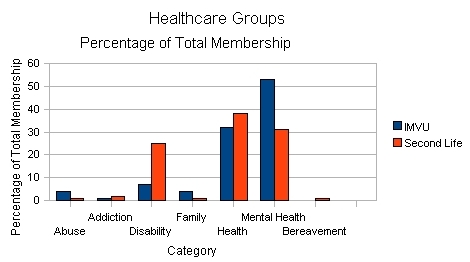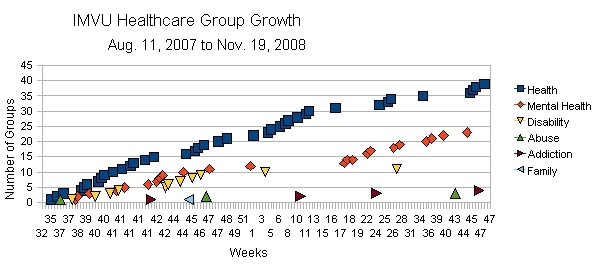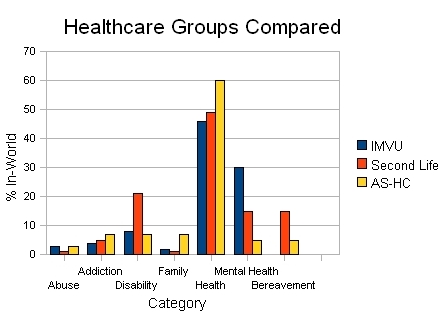So, after Lively, I’ve decided to take a look at other virtual worlds besides Second Life.
Abstract: IMVU is an avatar based instant messaging environment. It allows for participation of anyone from 13 years of age and older. There are well over 100 healthcare support groups in IMUV. Many are more informal than those within Second Life, SL, or listed in the American Self-Help Group Clearinghouse, AS-HC. The number of groups and their membership can be broken down into categories, with similar amounts to SL and AS-HC. However, there are some differences, higher Mental Health, lower Disabilities groups and membership, that may be due to to younger demographics of IMVU. There is a long tail effect with a few groups having large memberships, but the majority having only a few members. Group growth rates can also me determined with many starting around the same time, but growing at differing rates.
Quick Overview of IMVU:
IMVU is an Instant Messaging Service (1) with a heavy graphical user interface. It is a 2.5d type space which is room based, one does not really walk around much. Indeed, the focus on developing IMVU has been on avatars and not land.(2) IMVU offers free accounts as well as paid. Users can be 13, with parent permission, or over. Users can generate content, and goods can be bought and sold. They currently have 20 million registered users and have been around since 2004.(3) Average User age is younger, perhaps 12-17 (4)
What’s an IMVU health group?
The groups area is well thought out and includes an online discussion forum as well as the possibility to meet up inworld. Groups are assigned to categories. I looked at the “Real Life/Health” groups for my research.(5) Of the 331 groups IMVU listed in that Health subcategory, I identified 142 as being about health. (Some of the group’s details suggested that at one time IMVU credits were given to people if they started a group. If true, and I saw it in several groups’ details, it would skew some of this data.)
I found a large number of seemingly simple ‘chat’ type groups within this health category. Many had no firm theme and only a modest amount of members. I am unsure as to what sort of health issues these should be understood to be dealing with. For 142 health groups I identified, 13, or roughly 10% were such chat groups. I left them out of my beginning analysis.
I attempted to categorized the rest under the American Self-Help Group Clearinghouse’s categories.(6) Some additional groups did not seem to fit, 31, so I left those out at this juncture. I did not see any groups that classified as Bereavement, but several of the chat oriented groups might qualify as they include ‘loss’, and other difficulties. However, I did not include them in the analysis below:
Number of Groups by Category Compared:
For 92 groups, here’s the number of groups, the category, and their percentage:
(Second Life, American Self-Help Clearinghouse)
3 Abuse 3% (SL >1%, AS-HC 3%))
4 Addiction 4% (SL 5%, AS-HC 7%))
11 Disability 8% (SL 21%, AS-HC 7%))
2 Family 2% (SL >1%, AS-HC?))
42 Health 46% (SL 49%, AS-HC 60%))
27 Mental Health 30% (SL, 15%, AS-HC 5%)
? Bereavement ?% (SL 4%, AS-HC ?%)
I took the IMVU groups and placed them into the categories used by American Self-Help Clearinghouse. I then looked at the categories as a percentage on the whole. I had done this with Second Life and American Self-Help Clearinghouse earlier (7).
Generally, the same percentages hold across all support group communities. However, IMVU was much higher in the Mental Health category. I am not sure why Mental Health would be so high in IMVU, but have some thoughts on the matter.
Mental Health’s high percentage testifies to the sheer number of Mental Health groups and a variety, of sorts, to their approaches. From looking at the groups, they do not seem to be addressing specific, clinical, mental health issues, say agoraphobia, or depression. The groups seem to be more informally oriented towards addressing people who are not happy, or need someone to talk to. This may be due to the younger demographics than in Second Life. Perhaps the younger community is more interested in talking, or framing their conversations, more informally. It may be that these younger members have these types of issues more than the presumably older Second Life or AS-HC community. It may be that a smaller learning curve draws in more people, diluting the number of people with less formal mental health needs. Also, those that need more formal help may be more willing to learn the complex tools of Second Life, or attend AS-HC meetings, to better have their needs met.
Interestingly, IMVU disability is about the same as AS-HC, and not as high as in Second Life. I will take more of a look at this, below.
Number of Members per Category Compared:
For all health groups I identified, including those not categorized, there are 3288 members. The groups I categorized have a total of 2227 members. I then looked at the percentage of memberships in each category over all 2227 members. In IMVU an avatar can be a member of more than one group. I did not see any limit to the number of groups one could be a member of. Second Life currently limits an avatar to 25 groups.
Here’s the categories and the percentage of membership. (Second Life):
Abuse 4% (SL <1%)
Addiction 1% (SL 2%)
Disability 7% (SL 24%)
Family 4% (SL <1%)
Health 32% (SL 38%)
Mental Health 53% (SL 31%)
Bereavement ?% (SL <1%)
Percentage of total by membership (not 100%)

Again we see the large interest in mental health. I think the prior analysis holds here as well. Not only are their a lot of mental health groups in IMVU, there are a lot of members involved in that area. This graph may also be explained by the younger demographic and easier tools of IMVU.
Conversely, the Disability membership is much higher for Second Life. My guess is that the advance communication and mobility features of Second Life are of such high value to the disabled population, they are less willing to inhabit IMVU.
As in Second Life, IMVU memberships demonstrate the long tail effect. There are a few large groups, some in each category, but groups with smaller memberships predominate.
(Note: Not all groups are named in the graph)
Top 10 groups by membership are:
Suicide, Depression, and Relationships, 639 members.
<Be Yourself>, 254 members.
Suicide Awareness, 217 members.
Fibromyalgia, 152 members.
Soul ~ Heart ~ Body & Holistic Health, 111 members.
Tickle Me Pink, 91 members.
Pregnant Teens, 83 members.
Straight Edge, 83 members.
Mental Health Survivors, 76 members.
*Helping and Sharing Medical Advises (sic), 74 members.
Groups that have been around longer tend to have more members. However, there are plenty of groups outside of this general rule.
Comparing IMVU Group Growth Rates
IMVU group information also lists when the group was first created. The first group was in August of 2007. We can look at how many groups were created in each week for each category
(Note: Possible promotions could effect this result.)

We already noted the differences in the quantity of each category. With this data and graph we have the opportunity to see the growth of the categories as in a timeline.
Four out of the six categories had groups started within the first two weeks. However, their rates were quite different. Health began quickly and was well sustained for a little more than half the period before it slowed. Disability steadily increased its rate during the first third of the period, and then did not do much for the remainder. Mental Health also increased its rate at the beginning, then plateaued, before once again, increasing at the end. Addiction started late and slowly increased the number of its groups. Abuse started at the beginning and added only a few groups during the period. Family came in nearly one third of the way into the period, and did not add anything else.
It would be insightful to see how this corresponded with the general increase of the IMVU population, however, i do not have that information available.
I wonder how the bunching of rate increases are due to IMVU promotions, or just people in the same communities sharing/having the idea to create a group at the same time.
The rates also seem to show that the Health and Mental Health groups found that IMVU is suited their purposes and so continued, whereas the other groups started, but soon found that IMVU was not their environment.
I am not able to get this sort of information from Second Life at this time. But I would be very curious to see if it is similar. One of the values of such a chart would be to help predict and prepare for support groups moving on their own into new worlds or media.
Discussion
I would like to continue visiting virtual worlds and doing similar research. With the demise of Lively, I want to be sure that we can learn what we can from these places while we have the chance.
IMVU had the added benefit of reporting the group’s start date. Being able to see, over time, a virtual world being populated by healthcare support groups drew me to this particular project.
EndNotes:
(1) “Instant Messaging Goes Graphical” Daniel Terdiman. Wired 09.16.04 http://www.wired.com/science/discoveries/news/2004/09/64969
(2)”Q&A: IMVU’s Cary Rosenzweig On “Building From The Avatar Up” worldsinmotion.biz 07.28.08 http://www.worldsinmotion.biz/2008/06/qa_imvus_cary_rosenzweig_on_bu.php
(3) “A Message from Cary Rosenweig, Cheif Executive Officer of IMUV” Cary Rosenweig 07.20.08 http://www.imvu.com/about/letter_from_caryjay.php
(4) Couldn’t quickly find demographics for IMVU so used Quantcast estimate. Age that visits the IMVU website. http://www.quantcast.com/imvu.com
(5) I collected group data on Nov. 23, 24 2008. I used the IMVU website’s groups area, going through the 331 groups listed in the subheading “Health”.
(6) “The Self-Help Group Sourcebook Seventh Edition” B White, E Madara 2002 Saint Clares Health Services. (http://www.selfhelpgroups.org/)
(7) “Statistics for Second Life Support Groups” John Norris. Oct. 19, 2008. john-norris.net. (http://john-norris.net/2008/10/19/statistics-for-second-life-support-groups/)





Very interesting research.
For my BA thesis, I researched the therapeutic potential of Second Life. It was fascinating project to be involved with — thus I am very interested in the work you are doing.
In my research, I also found an overwhelming focus on Mental Health groups.
I find it particularly interesting though that you found a smaller population of disabled users in IMVU compared to Second Life. I believe that speaks a ton to the graphical benefit of avatar mobility. I wonder if that is a similar trend among other virtual worlds.
Great Work! I am Chronos Laval in SL, let’s chat sometime.
Pingback: Research: Healthcare Support Groups in the Virtual World of IMVU : turtlethink.com
Thanks Mark/Chronos
That would have been an interesting thesis for sure.
I am a bit curious about the few disability groups/members as well. It would be interesting to add the SL TeenGrid into the SL stats. That might be a better demographic comparison.
I do think there is something to the higher mobility/activities in SL that would make it more attractive to those in the disability community. But I’d really like to have direct evidence.
However, based on this, if I knew someone in the disabled community, I would recommend SL higher than an IMVU type of world (all other things being equal.)
Pingback: Second Life Health News: Healthcare Support Groups « ScienceRoll
Dear John,
Once again, you’re doing some very interesting and trailblazing research.
Why IMVU users have so few bereavement groups, but so many mental health? You’ve indicated the younger age of IMVU users. Might it be that bereavement is much less of an issue for the vast majority of youngest, while national studies continue to reflect increasing rates of mental health problems for youth?
– Ed
Thanks, Ed…your the pro at this!
I think you are probably right. IMVU is skewed to a young audience. Perhaps because they do not experience as many people close to them dying, there is not as great a need for formal bereavement groups. (As a population, an individual youngster may indeed need and benefit from a bereavement group.)
And, as you note, many youth experience mental disorders, so there are enough of them to create a need. The recent report showing nearly half of college age people have experienced a psychiatric disorder in the last year, makes the point. C Blanco, et al. 2008*
Interestingly that same report says that only 25% sought treatment. Perhaps that is reflected in the more informal chat groups on IMVU and not more formal ‘treatment’ based groups.
*http://tinyurl.com/5omf5o
Pingback: Grupos de apoyo en salud virtuales « PI en Second Life
Pingback: Statistics for Second Life Support Groups
This is more than interesting. I guess I didn’t expect people to group together and discuss health help. Especially things like Abuse or what not, depending on the category of abuse. It’s very interesting and shines even more light on virtual worlds. Right on virtual worlds!
Pingback: Healthcare Support Groups in Different Worlds
Pingback: Community Management Related Research | john-norris.net
Interesting stats I myself do not go on sl but have been a vetran on IMVU for 7 years. I am just wandering if any of your findings featured people with neurological symptoms? Please feel free to visit me on The Pulse or at my Ø Tolerance to Cyberbullying group anytime!
IMVU Pulse:
http://www.imvu.com/catalog/web_index.php#pulse=/
IMVU Ø Tolerance to Cyberbullying group
My avi name is TEENEE
Thanks Tina. I didn’t track neurological symptoms as a category, but there seemed to be many people interested in that sort of topic. Unfortunately, I don’t have currently to recommend. Generally speaking, these folks do a good job at trying to keep up with who is doing what: http://www.mentalhelp.net/selfhelp/